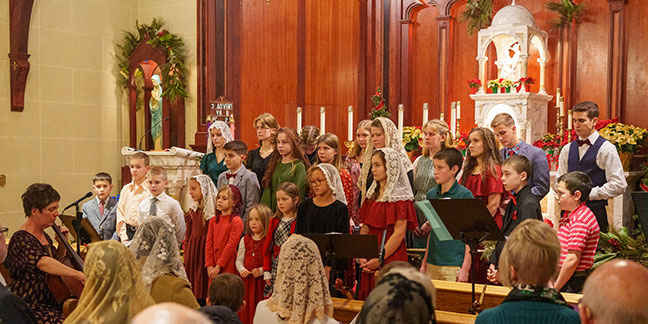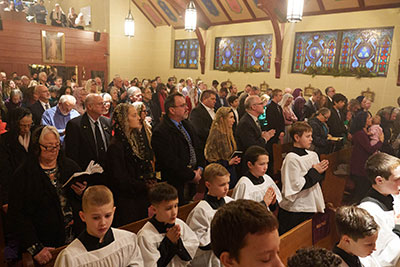‘We need a new church’
 More than 400 people cycled through St. John the Baptist Church in Tryon for three Masses and a special children’s Christmas concert on Dec. 17.TRYON — The vibrance of St. John the Baptist Parish was on full display Sunday, Dec. 17, when 400 people cycled through the small church for three Masses and a children’s Christmas concert.
More than 400 people cycled through St. John the Baptist Church in Tryon for three Masses and a special children’s Christmas concert on Dec. 17.TRYON — The vibrance of St. John the Baptist Parish was on full display Sunday, Dec. 17, when 400 people cycled through the small church for three Masses and a children’s Christmas concert.
As usual, dozens of parishioners arriving for the 8:30 a.m. Mass headed to the basement – which doubles as the church’s overflow area and “cry room” – to watch via livestream the service going on upstairs. With 16 altar servers, there wasn’t room for all of them in the sanctuary, so they sat in the front pews. Outside, traffic snarled in the parking lot between each Mass, and despite the dreary weather, folks gathered out front to chat beneath umbrellas because there’s no place to congregate inside.
“It was kind of a controlled chaos,” says Father Jason Christian, pastor, joking that crowds are a good problem for any church to have. “At one point there were 50 people on the patio waiting to get in, and everyone was fighting for parking space. We are completely landlocked on this site, so we really can’t expand.”
The Sunday crowd wasn’t simply a function of the Advent season or the concert, he says, but is a reflection of the vitality of the Catholic faith in the foothills of western North Carolina.
The scene outside and inside the 140-seat church aptly demonstrates what has become painfully obvious to the parish in recent months as St. John the Baptist worked its way through the Diocese of Charlote’s new parish planning process: “We need a new church,” Father Christian says.
“Everyone loves our little church,” he says. “I don’t think anyone is happy with the idea of leaving. It’s really bittersweet. If I could just double the size of the church and the parking lot, we’d be fine. But we need more space, that’s clear, so we can accommodate more people and more ministries.”
The capacity challenge isn’t new at St. John the Baptist. The parish has nearly 500 registered families, ticking up – despite the pandemic – from five years ago when Father Christian arrived. And pastors before him also recount struggles of trying to serve a congregation more than three times the church’s capacity.
What is new for St. John is that parishioners and church leaders named a new church as a priority as they developed their first-ever, six-year plan for the future – a document now required of all parishes in the diocese. And they wrote it all down in a detailed Parish Pastoral Plan, recently approved by Bishop Peter Jugis.
“Somehow when you write it down, it becomes more concrete,” says Father Christian, who is now turning his attention toward timing, logistics, fundraising and all the details that come with building a new church.
The parish is years away from any construction but has already begun to look for land, and Father Christian says he’s watching the economy and changes within the community and the diocese to help decide when the timing is right.
Planning with purpose
St. John was the first of the diocese’s 92 parishes and missions to participate in the diocese’s new Parish Pastoral Planning exercise. It generally begins a year before a pastor meets with the bishop to review the direction of his parish.
The process involves a straightforward document the pastor fills out with input from his parishioners, examining 14 areas of pastoral care – from how the parish is serving different populations, to catechesis and formation, to charitable works, schools, evangelization, facilities and more.
A parish must have a pastoral plan approved by the bishop before it may embark on any major construction project, to ensure the parish has adequately weighed factors that influence its overall health and longevity.
“With the growth we are experiencing across our diocese, we wanted to bring more structure to parishes’ planning for the pastoral care of the faithful under a pastor’s watch,” explains Monsignor Patrick Winslow, vicar general and chancellor of the diocese, who led development of the new planning process and who coincidentally spent six years as pastor of St. John the Baptist, overseeing its 2011 renovation.
“Renovations and other physical improvements are just one element a pastor, in collaboration with his parishioners, looks at as they create their long-term plans,” he said, “all in an effort to better serve the people and bring them closer to God.”
Parishioners weigh in
 The Tryon parish is an eclectic mix of tried-and-true locals, retirees, young families with children, rural and working-class folks, and horse enthusiasts who have relocated to the area to access the Tryon International Equestrian Center.
The Tryon parish is an eclectic mix of tried-and-true locals, retirees, young families with children, rural and working-class folks, and horse enthusiasts who have relocated to the area to access the Tryon International Equestrian Center.
Earlier this year, Father Christian gathered his parishioners together for a series of town hall-style meetings to discuss the needs, wishes and priorities of the parish from their perspective.
While there is a wide variety of interests among his flock – and multiple Masses and ministries to serve those interests – parishioners were nearly unanimous in their conclusion that the parish needs a new church.
Their desire for a Catholic cemetery in the area also ranked a high priority.
And with the number of parishioners, Masses and activities going on, Father Christian has also requested the support of a second priest to help him and his semi-retired deacon minister to his parishioners. While both are happy with their pastoral work, he says, the demand can strain their ability to always respond promptly.
Father Christian also serves as academic dean for St. Joseph College Seminary, 75 miles away in Mount Holly, where he spends at least two days a week teaching the 20 young men who are there to discern a vocation to the priesthood.
“Additionally, many of our parishioners come from long distances, which makes traveling for sacramental and pastoral care challenging,” he explained to the bishop in his pastoral plan. “The faithful have been very supportive but have also expressed a desire for greater priestly presence.”
To help bridge the gap and adjust for recent retirements, the parish recently hired two members of the Daughters of the Virgin Mother to assist with administration work at the parish office.
With the parish offertory at an all-time high, Father Christian believes the faithful at St. John can support a second priest. Still, he says, he – and his parishioners – understand demand is high across the growing diocese of 530,000 Catholics, “so we’re leaving that in the hands of God and the bishop.”
Living out their faith
With Bishop Jugis’ signoff, the parish hopes to have their plan for a new church well under way by the next time the pastoral planning process rolls around in 2030.
In the long term, unless they need the funds from a sale, parishioners also hope to retain their little church for the possible use as an oratory or a chapel for religious communities.
Founded in 1911, the original church on the same site just east of Tryon was destroyed in a fire and rebuilt in the 1960s.
In 2011, the building underwent an extensive interior makeover and now features custom woodwork, a coffered ceiling with dramatic arches and hues of red and blue, Italian marble altars, and gilded artwork of the church’s two patrons: a fleur-de-lis representing the Blessed Virgin Mary and a shell representing St. John the Baptist.
The high altar containing the tabernacle is made from red and white Carrera marble and depicts the scene of St. John the Baptist baptizing Jesus at the river Jordan. Above it, the crucifix is framed by the shape of a cross.
The church’s Neo-Gothic design is meant to emphasize its motto: “That in all things God may be glorified.”
That motto, Father Christian says, is evident every day as the people of St. John live out their faith.
On the Third Sunday of Advent, known as Gaudete or Rejoice Sunday, the earliest arrivals gathered in the dimly lit church before dawn to pray the rosary and prepare for the 8:30 Mass. The crowd swelled to 250 people, then, flanked by poinsettias and Christmas trees, the children gathered in front of the altar to cheerily sing in anticipation of Christmas – engaging parishioners to accompany them.
With Christmas just a week away, the spirit of the music and the hope for the future reflected the theme of waiting that Father Christian focused on in his homily: “The Bridegroom is near. In a short while He will be coming.”
— Liz Chandler. Photos by César Hurtado


